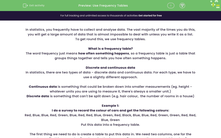In statistics, you frequently have to collect and analyse data. The vast majority of the times you do this, you will get a large amount of data that is almost impossible to deal with unless you write it as a list.
To get round this, we use frequency tables.
What is a frequency table?
The word frequency just means how often something happens, so a frequency table is just a table that groups things together and tells you how often something happens.
Discrete and continuous data
In statistics, there are two types of data - discrete data and continuous data. For each type, we have to use a slightly different approach.
Continuous data is something that could be broken down into smaller measurements (eg. height - whatever units you are using to measure it, there's always a smaller unit.)
Discrete data is something that can't be split down (e.g. hair colour, the number of rooms in a house)
Example 1:
I do a survey to record the colour of cars and get the following colours:
Red, Blue, Blue, Red, Green, Blue, Red, Red, Blue, Green, Red, Black, Blue, Blue, Red, Green, Green, Red, Red, Blue, Green
Put this data into a frequency table.
The first thing we need to do is create a table to put this data in. We need two columns, one for the category (in this case colour) and one for the frequency (how many times we get this colour).
| Colour | Frequency |
| Red | |
| Blue | |
| Green | |
| Black |
We now need to count how many of each colour we have, and this will give us the following, complete frequency table:
| Colour | Frequency |
| Red | 8 |
| Blue | 7 |
| Green | 5 |
| Black | 1 |
Example 2:
I measure the heights of some children and get the following results (all given in centimetres):
132, 145, 165, 133, 142, 147, 152, 161, 164, 131, 135, 137, 149, 148, 171, 140, 150
Put this data into a grouped frequency table.
This one is slightly different - we can't use exactly the same approach as before because all the numbers are different. This will usually happen if you are measuring something that can be measured on a scale, such as heights or weights.
To deal with this, we use a grouped frequency table. The difference between this and a frequency table is that instead of having one thing for the category, we have a range.
| Height (cm) | Frequency |
| 130 < h ≤ 140 | |
| 140 < h ≤ 150 | |
| 150 < h ≤ 160 | |
| 160 < h ≤ 170 | |
| 170 < h ≤ 180 |
Let's take a couple as examples.
The first number is 132, which would clearly go into the 130 < h ≤ 140 box.
The last number is 150 - you have to think about this a bit more. 140 < h ≤ 150 means anything up to and including 150, whereas 150 < h ≤ 160 means anything above 150.
150 would go into the 140 < h ≤ 150 box.
| Height (cm) | Frequency |
| 130 < h ≤ 140 | 6 |
| 140 < h ≤ 150 | 6 |
| 150 < h ≤ 160 | 1 |
| 160 < h ≤ 170 | 3 |
| 170 < h ≤ 180 | 1 |
Time for some questions now.








